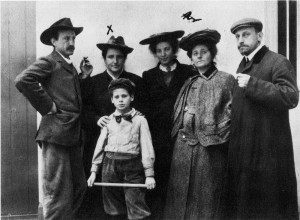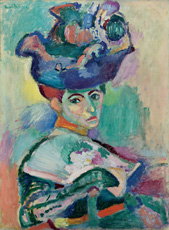 The Steins Collect: Matisse, Picasso and the Parisian Avant-Garde at the San Francisco Museum of Modern Art
The Steins Collect: Matisse, Picasso and the Parisian Avant-Garde at the San Francisco Museum of Modern Art
Several people had tears in their eyes, myself included, walking in a trance through the vast rooms of SFMOMA, in the stream of some 600 people who had gathered at the Donors’ opening party and walk-through. “The Steins Collect” is not just a major San Francisco art exhibition, it’s the most ambitious exhibition SFMOMA has ever shown, as director Neil Benazra proudly announced. In one word: it is huge, both in mass and in importance. The very hour when modernism was born, a good century ago, has never been so densely packed and complete in one space. This overwhelmingly broad, bold collection goes back to one American family in Paris. Among the most famous “Americans in Paris,” the Stein siblings were the first to recognize the new era, the revolution in art, and bought, supported and connected the artists through their celebrated salons.
Leo Stein, Gertrude’s two-year-older brother (with whom she had had childhood shooting parties in the wild Oakland hills, followed him to Harvard and Johns Hopkins Medical School, then to Florence to take a deep look at art) took the lead in Paris. In 1903, Leo and Gertrude were settled together in Montparnasse, at 27, Rue de Fleurus. A year later, Michael Stein, the oldest brother (whose business acumen secured all the siblings the means to be “well off”), followed with his wife Sarah, an ambitious and competitive salonnière, settling nearby in St. Germain’s 5, Rue Madame. Leo and Gertrude first started with impressionist works, focusing on nudes — Manet, Manguin, Bonnard, Renoir. (Here you already notice the pronounced interest of Gertrude Stein in the erotic and sexual, which goes like a red thread through her written work as well: see my earlier blog posts.) Then, as curator Janet Bishop explained to the patrons, they “took the plunge” and bought the scandalous Matisse painting “Woman with a Hat” — a portrait that got the Parisians so enraged in defense of women’s honor that people physically attacked it at its first public showing. That same year Leo and Gertrude discovered the 21 year-old, totally unknown Picasso… and soon the salon walls were stuck with rows upons rows of paintings that made their salon, in Hemingway’s words, “one of the best rooms in the finest museum” in the world.

The hunt for paintings took the two Stein couples into fierce competition. Their rivalry ended up making Matisse the genius who was celebrated at Rue Madame, while Picasso and Cézanne were the patron saints at Rue de Fleurus – until Leo felt unable to follow Picasso’s move into Cubism while Gertrude found her soul brother right there, in Picasso’s dilapidated studio in Montmartre, taking on the Cubist vision into her writing. Leo’s scorn for this new Picasso as well as for his sister and the “Godalmighty rubbish” she was writing led to the bitter and lifelong separation of the siblings. Leo moved to Italy; Alice B .Toklas replaced him at Gertrude’s side. The rest is history.
Some of these walls at SFMOMA are beautifully represented with wall-size photographs. You stare at them, and are stunned to find a good number of the spectacular paintings – Cézanne’s “Apples,” Picasso’s “Young Boy Leading a Horse” and “Lady With a Fan,” Matisse’s Blue Nude” and Cézanne’s many “Bathers” — hanging right next to the photographs, as real and fresh and startling as they were 100 years ago. You even find some of the original side-board furniture from the studios – spinning you into a time-warp that equals Woody Allen’s latest fantasy of being transported right back into the Parisian avant-garde in “Midnight in Paris.”
For me it was partly an exciting déjà vu. I had seen the reconstruction of the entire Rue de Fleurus studio in an exhibition at Beaubourg (Centre Georges Pompidou) in Paris, in the eighties, and for years I had combed through the catalogue of the precursor of this remarkable SFMOMA show, the 1970 “Four Americans in Paris” at the New York MOMA. I had seen Picasso’s world-famous portrait of Gertrude Stein, but this time, thanks to the in-depth experience of “Seeing Gertrude Stein: Five Stories” at the Contemporary Jewish Museum in San Francisco, I saw the work with fresh eyes. I was, to say it simply, blown away. What Picasso captured, after some 80 sittings (according to Stein), is something you don’t often see in the many hundreds of existing photographs of Stein: the sharp, keen intelligence of this beautiful Jewish face as well as a dark, brooding quality that she had as a young woman who still doubted her own artistic powers.
Back then, Stein was “writing for myself and strangers;” she was often “despairing” in her desire to be seen, understood, and recognized. Her friend Picasso saw and recognized her. He painted her, as Wanda Corn, the curator of “Seeing Gertrude Stein: Five Stories” pointed out, in the style of a classical male portrait: leaning forward but facing with great intensity on something within herself, something on her mind. She has no flowers or fans in her hands, as women always did in classical paintings – her hands rest upfront on her lap like the hands of a male creator.
In her private notebooks of that time, Stein had put down a note of envious longing: “Pablo and Matisse have a maleness that belongs to genius. Moi ausi (sic) perhaps.” (“Me, too, perhaps.”) Picasso, in this first of many portraits made of Stein, gave it to her. His was the first of numerous portraits, all picking up on the fascinating androgyny of Stein.
Her comment? “..for me, it is I, and it is the only reproduction of me which is always I, for me.” (Picasso) Picasso’s comment? “Yes, he said, everybody says that she does not look like it but that does not make any difference, she will…” (The Autobiography of Alice B. Toklas)
Stay tuned.




Pingback: Why Do Something If It Can Be Done: Quoting Gertrude Stein # 68 … | Oil Painting Outlet
Pingback: Why Do Something If It Can Be Done: Quoting Gertrude Stein # 69 | Quoting Gertrude Stein
Pingback: Why Do Something If It Can Be Done: Quoting Gertrude Stein # 69 « Renate’s Website